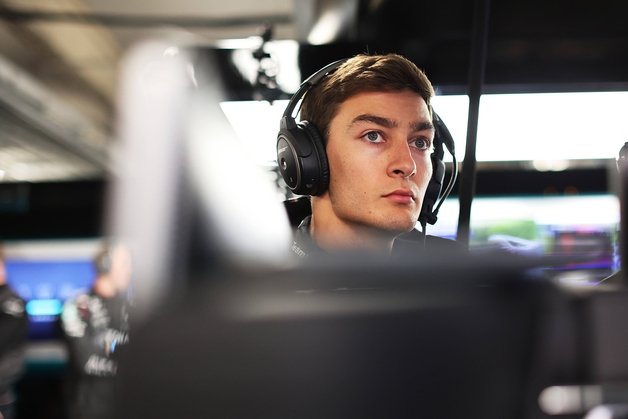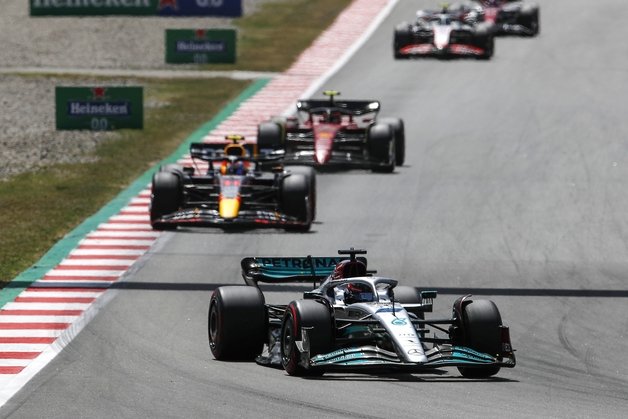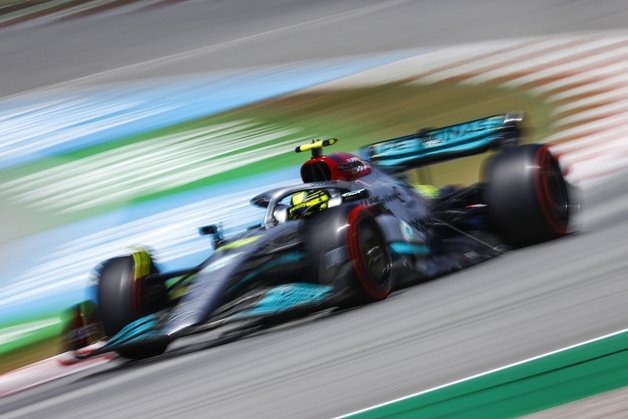The Porpoising Problem Plaguing Mercedes


It has been a double-whammy of rough times for the once untouchable Mercedes AMG F1 team over the past few months. First, Max Verstappen knocked Lewis Hamilton off his perch by taking the 2021 World Drivers' Championship and prevented the Brit from becoming the outright greatest of all time by title wins. Then 2022 has brought technical changes that the team hasn't adapted to and has seen them slide down the order to face the prospect of a win-less season. So how did it all go wrong?
In a word: porpoising. The bouncing cars that plague the sport this year are an unintended consequence of the aerodynamic rules the FIA introduced. The underfloor pull, otherwise known as ground-effect aero, has worked in keeping the cars glued to the road, but a little too well. This year, when each vehicle's floor gets too close to the track surface and hits it, the suction stops, the car springs back up to its ride height, and the whole process begins again.
Although some teams have suffered from the problem, it's not universal up and down the grid. Mercedes has tried and failed to get on top of the issue, and their difficulties are costing them any chance of wins, and they're losing points to Red Bull and Ferrari each race. 2022 may be a long season, but despite time to turn it around, I suspect the team knows they won't be challenging for either championship this year. So, it will be a rough remaining six months to endure before the 2023 car design can learn from 2022's mistakes.

This week's Silverstone Grand Prix has several upgrades for the Mercedes W13 that the team – and drivers – hope will ease their misery. A similar package arrived for Barcelona, and Mercedes had some decent pace for the Spanish Grand Prix. George Russell fought both Red Bull cars in wheel-to-wheel racing and did admirably despite the speed advantage the RB18 has. Hamilton, too, was quick as he fought back from a Lap 1 incident, and Mercedes seemed the only team who was snapping on the heels of the lead Red Bull-Ferrari top two after battling McLaren, Alpine, and Alfa Romeo elsewhere.
However, that brief interlude only proved to be a short respite from the porpoising headache, and the subsequent street circuits showed that Mercedes didn't fully solve their issues. The smooth road surface of the Circuit de Barcelona-Catalunya helped mask their problems a little. However, the bumpy streets of Monaco, Baku, and Montreal demonstrated that their porpoising solution was not a permanent fix.
With Lewis Hamilton complaining of physical back problems at Baku, and a chorus of other drivers worrying about porpoising's health and safety ramifications, the FIA took action in the run-up to the Canadian Grand Prix. The governing body announced a technical directive to reduce porpoising's impact. Labeled as a band-aid solution by Russell, the fix should prevent the drivers from racing under painful conditions and allow them to concentrate on driving rather than suffering.

However, the FIA's intervention might hinder Mercedes more than help. It forces the teams to make sure the porpoising – or vertical oscillations, as the FIA calls it – fall within certain limits rather than flat-out fixing the issue. That is to say that the teams are responsible for solutions to stop extreme bouncing, be it from setup changes or new part developments so that FIA sensors deem the movement to be within safe parameters.
Although Mercedes' main rivals believe that the German manufacturer is receiving preferential treatment from the rule's introduction, it's not so clear cut. While Red Bull, for example, isn't suffering from the issue, at least not to the same extent, they won't have to make many or any setup changes. Mercedes, meanwhile, will have to increase their ride height to stop the problems, which reduces car stability, and in turn, should slow down the car.
However, if Mercedes has resolved the issues with their Silverstone upgrade package, they might be turning a corner at the British Grand Prix. Like Barcelona, the Silverstone circuit is smooth, so porpoising shouldn't be as significant a problem as elsewhere, anyway. Moreover, the Austrian, French, and Hungarian Grands Prix are on relatively level surfaces, too, so the July races could have Hamilton and Russell far more competitive than they've been throughout 2022.

The FIA's intervention will mean some other teams like Ferrari, who also have porpoising issues, but not to the same extent as Mercedes, may need to change their car setup to fall within the tolerance levels of the new rules. That slight change might be enough to have them lose a tenth or two per lap, and that could be all the difference for Mercedes to catch up – especially if their upgrades are as potent as they hope. In F1, any advantage is worthwhile, and you'll note Hamilton and Russell have complained the loudest about porpoising.
There isn't a silver bullet for the Silver Arrows that will catapult them back to the front of the pack as they're used to. Still, the gradual improvements and potentially beneficial rule changes should have them back amongst the frontrunners before the season's out. That's a long way from their lofty standards of where they want to be. Dominating unchallenged at the top will be their target. It's good for the sport that they're not, but F1 needs as many teams as possible in contention to win, so Mercedes getting closer is best for all. Perhaps they'll bridge that gap this weekend.
